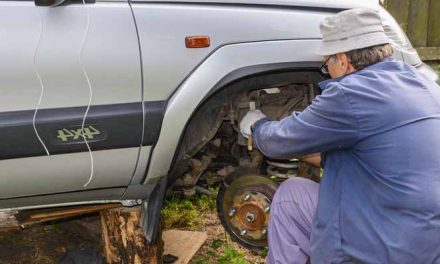“Yeah, those things are like Legos. Just find the right part and snap it on.”
I grunted into my greasy cellphone.
If only my brother — an experienced mechanic and LeMons racing driver — was underneath my 2001 Jeep Wrangler TJ 2.0-liter with me.
He wouldn’t have been so sanguine about do-it-yourself (DIY) repairs to these tough little workhorses.

Replacing the starter had been a cinch … but loosening the rusted straps that held the gas tank in place was a battle.
I’d already busted my knuckles as my socket drive slipped off the badly rusted bolts.
Eventually I had the old, vapor-leaking tank out and a replacement, courtesy of eBay, installed.
I’m embarrassed by how little I paid for “Tseepie.”
I found it at a roadside used-car lot. A vehicle identification number search showed it’d spent most of its life in Pennsylvania, where salt on winter roads has a predictable effect.
I said the magic words, “frame rust,” and the salesman cut the price in half.
Since then, I’ve spent five times the purchase price on parts for my DIY rebuild project.
I’ve worked on cars since I was 16.
At first it was out of necessity: I couldn’t afford to have anyone else do it. Then it became a habit. Why pay someone to change my brake pads? It takes me 45 minutes to do four wheels.
Restoring Tseepie is as much about revisiting my youth as about saving money.
But for millions of American households, DIY auto care could soon become an essential life skill. And that means money to be made…
A Nation of Home Mechanics
When the next economic downturn hits, owning shares in auto parts chains may prove an excellent investment choice … as it did in the last recession of 2008 to 2009.
Recent years haven’t been kind to the aftermarket auto parts industry. Years of design changes and quality improvement mean most modern vehicles don’t need much maintenance.
But that’s about to change … thanks to three factors.
First, even the most smartly designed and manufactured car eventually needs repairs to hard-working systems like the brakes or suspension. Alternators, air conditioning compressors and starters wear out.
That’s starting to hit U.S. drivers. Of the 100 million-plus new cars sold in the U.S. since 2012, half are 3 years old or older, with an average odometer reading of 70,000 miles.
That’s when out-of-warranty repairs and maintenance becomes a reality … and when cost-conscious drivers start thinking about what they can do for themselves.
Second, the U.S. household automobile fleet is overleveraged.
Outstanding vehicle loan balances stand at a record $1.26 trillion.
Repair rather than replacement is the only viable option for an increasing number of car owners.
Used-Car Supply Down, Prices Up
A third factor is leading people to the local auto parts store.
Over the last decade, strong demand and low interest rates produced a 25% increase in the average price of a new vehicle — $35,285, according to Edmunds.com.
Many people are shopping for used cars instead. But supply is tight.
Vehicle production between 2009 and 2012 — the depth of the financial crisis — was extremely low by historical standards. Since cars of that age are their main source, used-car dealers are raising prices.
So much so, that many drivers are buying even older vehicles and fixing them up.
Cars 12 years old and older already account for almost half of U.S. vehicles. About 81 million autos will have been on the road 16 years or longer by 2021, compared with 62 million in 2016 and 35 million in 2002.
Somebody Always Makes Money Somewhere Along the Line
Many vehicles built prior to 2005 — like my Tseepie — are in a technological in-between stage.
They are advanced enough to feature electronic ignition and other modern features, but old enough to be amenable to DIY mechanics. With the U.S. fleet containing so many of them, in the next recession cost-conscious drivers will flock to buy parts they can install themselves.
Consider investing in auto parts dealers such as O’Reilly Automotive Inc. (Nasdaq: ORLY). The stock is cheap, with a price-to-earnings ratio of 22.6.
It’s up 50.2% in the last year. And it’s got room to run even further.
If ever there was a good time to take advantage of hidden economic trends like this … as I regularly advise readers of my Bauman Letter … it’s now.
Kind regards,

Ted Bauman
Editor, The Bauman Letter



